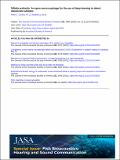Files in this item
Silbido profundo : an open source package for the use of deep learning to detect odontocete whistles
Item metadata
| dc.contributor.author | Conant, Peter C. | |
| dc.contributor.author | Li, Pu | |
| dc.contributor.author | Liu, Xiaobai | |
| dc.contributor.author | Klinck, Holger | |
| dc.contributor.author | Fleishman, Erica | |
| dc.contributor.author | Gillespie, Douglas | |
| dc.contributor.author | Nosal, Eva-Marie | |
| dc.contributor.author | Roch, Marie A. | |
| dc.date.accessioned | 2023-01-20T15:30:10Z | |
| dc.date.available | 2023-01-20T15:30:10Z | |
| dc.date.issued | 2022-12-27 | |
| dc.identifier | 283033038 | |
| dc.identifier | de0d03ea-698f-4aa3-8a87-3858658c1220 | |
| dc.identifier | 85145425255 | |
| dc.identifier | 000904650700002 | |
| dc.identifier.citation | Conant , P C , Li , P , Liu , X , Klinck , H , Fleishman , E , Gillespie , D , Nosal , E-M & Roch , M A 2022 , ' Silbido profundo : an open source package for the use of deep learning to detect odontocete whistles ' , Journal of the Acoustical Society of America , vol. 152 , no. 6 , pp. 3800-3808 . https://doi.org/10.1121/10.0016631 | en |
| dc.identifier.issn | 0001-4966 | |
| dc.identifier.other | Jisc: 826488 | |
| dc.identifier.other | ORCID: /0000-0001-9628-157X/work/127066286 | |
| dc.identifier.uri | https://hdl.handle.net/10023/26799 | |
| dc.description | Funding: The authors wish to thank Dr. Michael Weise of the Office of Naval Research (N00014-17-1-2867, N00014-17-1-2567) for supporting this project. We also thank Anu Kumar and Mandy Shoemaker of U.S. Navy Living Marine Resources for supporting development of the data management tools used in this work (N3943020C2202). | en |
| dc.description.abstract | This work presents an open-source matlab software package for exploiting recent advances in extracting tonal signals from large acoustic data sets. A whistle extraction algorithm published by Li, Liu, Palmer, Fleishman, Gillespie, Nosal, Shiu, Klinck, Cholewiak, Helble, and Roch [(2020). Proceedings of the International Joint Conference on Neural Networks, July 19–24, Glasgow, Scotland, p. 10] is incorporated into silbido, an established software package for extraction of cetacean tonal calls. The precision and recall of the new system were over 96% and nearly 80%, respectively, when applied to a whistle extraction task on a challenging two-species subset of a conference-benchmark data set. A second data set was examined to assess whether the algorithm generalized to data that were collected across different recording devices and locations. These data included 487 h of weakly labeled, towed array data collected in the Pacific Ocean on two National Oceanographic and Atmospheric Administration (NOAA) cruises. Labels for these data consisted of regions of toothed whale presence for at least 15 species that were based on visual and acoustic observations and not limited to whistles. Although the lack of per whistle-level annotations prevented measurement of precision and recall, there was strong concurrence of automatic detections and the NOAA annotations, suggesting that the algorithm generalizes well to new data. | |
| dc.format.extent | 9 | |
| dc.format.extent | 3670426 | |
| dc.language.iso | eng | |
| dc.relation.ispartof | Journal of the Acoustical Society of America | en |
| dc.subject | Acoustics and ultrasonics | en |
| dc.subject | DAS | en |
| dc.subject | MCC | en |
| dc.title | Silbido profundo : an open source package for the use of deep learning to detect odontocete whistles | en |
| dc.type | Journal article | en |
| dc.contributor.institution | University of St Andrews. School of Biology | en |
| dc.contributor.institution | University of St Andrews. Sea Mammal Research Unit | en |
| dc.contributor.institution | University of St Andrews. Scottish Oceans Institute | en |
| dc.contributor.institution | University of St Andrews. Sound Tags Group | en |
| dc.contributor.institution | University of St Andrews. Bioacoustics group | en |
| dc.contributor.institution | University of St Andrews. Marine Alliance for Science & Technology Scotland | en |
| dc.identifier.doi | https://doi.org/10.1121/10.0016631 | |
| dc.description.status | Peer reviewed | en |
This item appears in the following Collection(s)
Items in the St Andrews Research Repository are protected by copyright, with all rights reserved, unless otherwise indicated.

